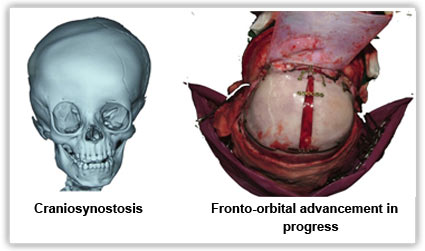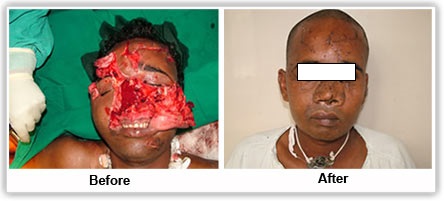Have a question?? Book an appointment!!
Surgery performed on the skull and facial bones is referred to as cranio-maxillo-facial surgery. These surgical procedures are used to correct deformities caused by trauma, birth deformities, tumors etc.
Soft tissue injuries
Soft tissue injuries of the face are common today due to accidents. Most people would like to avoid any sort of scars or marks on their face. A plastic surgeon can make sure that you get the least possible scarring or visible marks on the face, though it may not be possible to completely remove all the marks with all the technology and facilities available today. Timely and appropriate management of facial injuries can help to avoid multiple reconstructive procedures at a later date.
The lower jaw is called as the mandible. Some fractures of the lower jaw can lead to disturbances in the pattern of occlusion. These fractures cause facial deformity, pai, swelling and teeth to be loose and mobile. Some of these may need surgery to treat them. These fractures need to be treated with either plates and screws or wires and arch bars or a combination of all these. Sometimes it may be necessary to wire both the upper and lower jaw together. For some period of time. The ideal time to these major procedures is when the swelling goes down, within the first ten days of the injury. Most of the time it is possible to treat these fractures by operating through the mouth wit out any external incisions. However, in some cases it may be necessary to make some external incisions, which are relatively inconspicuous.

The upper jaw is called as the maxilla. Some fractures of the upper jaw can lead to disturbances in the pattern of occlusion. These fractures cause facial deformity, pain, swelling and teeth to be loose and mobile. Some of these may need surgery to treat them. These fractures need to be treated with either plates and screws or wires and arch bars or a combination of all these. Sometimes it may be necessary to wire both the upper and lower jaw together. for some period of time. The ideal time to these major procedures is when the swelling goes down, within the first ten days of the injury.
Most of the time it is possible to treat these fractures by operating through the mouth wit out any external incisions. However, in some cases it may be necessary to make some external incisions, which are relatively inconspicuous.
For some reason if the surgery is delayed, corrective surgery can be undertaken at a later date.
Nasal bone fractures
Fractures of the nasal bones can result from direct trauma to the face. There may be deviation of the with obstruction to one or both nostrils. The usual treatment for these deviated noses is to straighten the nose and realign the fractured bones as early as possible the ideal time for surgery is within one week of trauma.
For some reason if the surgery is delayed, corrective surgery can be undertaken at a later date.

Zygoma fractures
The cheek bone is known as the zygoma. This is commonly fractured due to a direct injury to the cheek bone. This is common in a road traffic accident. These fractures cause facial deformity, pain, swelling and may cause difficulty in opening the jaw. These fractures that are displaced need to be treated surgically. These fractures need to be treated with either plates and screws or wires or a combination of all these. The ideal time to these major procedures is when the swelling goes down, within the first ten days of the injury.
Most of the time it is possible to treat these fractures by operating through the mouth wit out any external incisions. However, in some cases it may be necessary to make some external incisions, which are relatively inconspicuous. For some reason if the surgery is delayed, corrective surgery can be undertaken at a later date
When both the upper and lower jaw bones along with the orbital bones are fractured, they are referred to as pan facial fractures these are very complex injuries and can be associated with head injuries. They can cause facial deformity and disturbances in occlusion. Sometimes treatment of these can be complex and can need repeated surgery.

Sometimes it may be necessary to wire both the upper and lower jaw together. For some period of time. The ideal time to these major procedures is when the swelling goes down, within the first ten days of the injury.
Most of the time it is possible to treat these fractures by operating through the mouth wit out any external incisions. However in some cases it may be necessary to make some external incisions, which are relatively inconspicuous.
For some reason if the surgery is delayed, corrective surgery can be undertaken at a later date.
3 D Printed implants
One of the new techniques is to use custom – made 3 D printed implants for reconstruction of complex defects. These allow for precise connection of the defects following surgery.